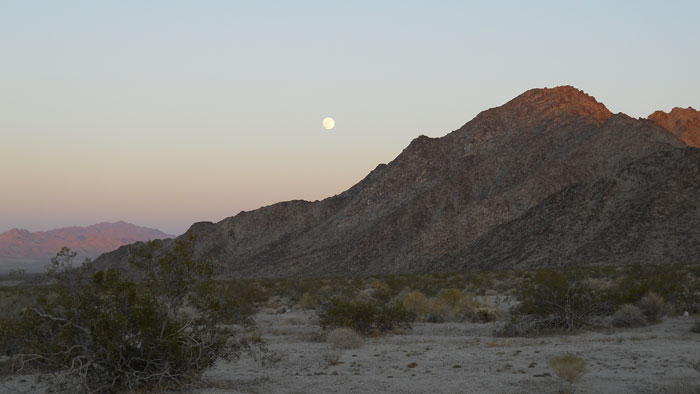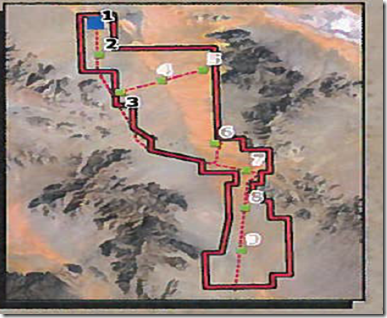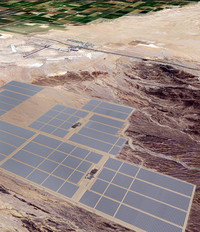February 3, 2012
Wind Project Proposed for Eastern Edge of Joshua Tree National Park
Desert Air Renewables LLC, a subsidiary of First Wind Holdings LLC, is proposing to place up to nine meteorological towers on 63,354 acres of public land in the jurisdiction of Needles and Palm Springs Bureau of Land Management offices. These Met towers will be used to determine wind potential for a possible large-scale wind project on the eastern edge of Joshua Tree National Park.
The area is in southeastern San Bernardino County and northeastern Riverside County, California. State Routes 62 and 177 would be access roads. Each Met tower would be 197 feet tall. Off road travel will be required to install the towers, including a 4-ton truck.
See the Met tower right-of-way grant application >>here.

^Northern boundary of Joshua Tree National Park along the Coxcomb Mountains, looking eastward towards Cadiz Valley and the wind project proposed location filling the valley. The project would be sandwiched in between the park, Sheephole Valley Wilderness, and Palen-McCoy Wilderness.

^Map of Met tower project location between the Coxcomb Mountains and Palen-McCoy Wilderness.
December 21, 2011
Solar Millennium Bankrupt
Solar Millennium AG announced they are bankrupt and their deal to sell US projects has been put on hold. The US project rights will most likely be sold as part of bankruptcy proceedings, which will lead to delays. More than likely, none of the projects will qualify for the federal 1603 program cash grant, making financing more difficult, but not impossible. Solar Millennium had returned the Department of Energy loan guarantee it had been awarded for the Blythe Solar Power Project, so its situation differs from that of Solyndra.
Solar Millennium, a German company, said it could not find partners for large projects in the United States -- Blythe, Palen, Ridgecrest, and Amargosa Farm Road -- and Spain -- the Ibersol project. This US pipeline of projects was to total 2,250 MW.
Before shares in the company were suspended on Wednesday they had lost 9.3 percent. The company has a market capitalization of about 14 million euros ($18.4 million).
Yet a day later Solarhybrid AG’s Chief Financial Albert Klein said he was still “very interested” in buying Solar Millennium's U.S. projects. Solarhybrid, another German company, is talking with authorities about permits and grid connections, and with utilities about power purchase agreements, Klein said. “We will only invest and spend our money if we can be sure that the plants will be built.” They may be holding out for a deal on price. Solarhybrid is still in talks with First Solar to supply the projects with Cadmium-Telluride thin-film photovoltaic panels.
October 7, 2011
SB 226 Provision Expands CEC Jurisdiction

The Senate bill SB 226 was signed by California Governor Brown today, legislation that deals mostly with easing state environmental quality rules for urban infill projects and solar panels on roofs and in parking lots.
But a provision tacked on in the final hours of the legislative session that ended September 9 would expand the California Energy Commission’s jurisdiction over solar projects.
The Energy Commission has approved several large-scale solar projects: Blythe Solar Power Project, Ridgecrest Solar Power Project, Calico Solar Power Project, and Imperial Valley Solar Project, that have switched from solar thermal to photovoltaic power plants. The Warren-Alquisr Act allows the CEC to license thermal power plants only, such as solar thermal plants. Photovoltaic plants have not been in the jurisdiction of the Commission before this, but because of the design changes, questions have arisen.
Supplemental environmental analysis will still be required.
Current law gives county governments jurisdiction over all photovoltaic projects. But under the law taking effect January 1, developers of previously approved projects can bypass the local permitting process and go straight to the state agency for a simple change to their license.
In a signing statement, Brown said the law will “avoid costly and repetitive permitting” for renewable energy projects.
Local government officials criticized the law. They fear that the law is a first step toward giving Sacramento control over all photovoltaic solar projects; Riverside County alone has 118,000 acres slated for solar development.
Here is the provision:
25500.1. (a) The owner of a proposed solar thermal powerplants, for which an application for certification was filed with the commission after August 15, 2007, and certified by the commission and, of a project on federal land, for which a record of decision was issued by the Department of the Interior or the Bureau of Land Management before September 1, 2011, may petition the commission not later than June 30, 2012, to review an amendment to the facility’s certificate to convert the facility, in whole or in part, from solar thermal technology to photovoltaic technology, without the need to file an entirely new application for certification or notice of intent pursuant to Section 25502, provided that the commission prepares supplemental environmental review documentation, provides for public notice and comment on the supplemental environmental review, and holds at least one public hearing on the proposal.
July 30, 2011
Governor Brown Vows to "Crush" Opposition to Large-scale Renewable Projects
California Governor Jerry Brown said on July 26 at a Distributed Generation conference that his administration will "crush" efforts to block renewable energy projects in California, intervening in local disputes to overcome opposition.
"In Oakland, I learned that some kind of opposition you have to crush," Brown, the city's former mayor, said in a speech at University of California at Los Angeles. "Talk a little bit, but at the end of the day you have to move forward, and California needs to move forward with our renewable energy."
Brown said his office will "act to overcome the opposition," helping projects get through permitting and environmental challenges. The Democratic governor announced Friday that he had filed a legal brief urging a federal judge to deny Western Watersheds Project's filing for an injunction against the Ivanpah Solar Electric Generating Sysytem project now under construction on tortoise habitat in the Mojave Desert.
"We need a centralized base of arbitrary intervention to overcome the distributed political power that is blocking forward progress," Brown said.
Brown said despite state budget cuts and reduced spending in a weakened economy, California must invest in renewable energy. He was a pioneer in the area when he was governor before, from 1975 to 1983. At the time, he said, "all this stuff seemed far more marginal."
Returning to office this year for a third term, Brown said he will promote the creation of 20,000 new megawatts of renewable energy by 2020. He said it doesn't help that the subject is so complicated.
"In politics, complexity is the enemy of success," Brown said. "We deal in simplicity. We deal in shifting blame and responsibility. We deal in slogans."
Brown took a shot at Texas, saying that "whatever amount of oil they have over there in Texas, we have a hell of a lot more sun right here in California." Brown said "oil is just a bunch of fossilized vegetation that over time has become rather valuable." The sun, he said, is more abundant and powerful.
"At the end of the day, it's more secure, more sustainable," he said. "It's more Californian, more American."
The conference he spoke at was ostensibly about placing 12,000 megawatts of distributed renewable energy in the state, such as rooftop photovoltaic systems. But Brown emphasized 8,000 MW of central station utility-scale projects would also be pushed.
Representatives from Solar Done Right were invited to the conference, to represent small systems and residential rooftop solar policies, but Google, NRG (the majority shareholder of ISEGS), Bank of America, and other large companies were dominating the conversation. The good news is that the 12,000 MW of distributed generation apparently is moving forward, but corporate ownership of systems may squeeze out more democratically-owned smaller systems unless people speak out and tell the Governor that policies should inlcude them too.
Read more: http://blogs.sacbee.com/capitolalertlatest/2011/07/jerry-brown-pledges-to-crush-o.html#ixzz1TCwzNdoq
See also the Mojave Desert Blog: http://www.mojavedesertblog.com/2011/07/governor-browns-pledge-to-crush.html
July 7, 2011
Fire at First Solar’s Antelope Valley Solar Ranch One
 Many counties and communities are grappling with the potential impacts to emergencey repsonse in remote desert areas, and this fire in dry grassland is in the more densely populated West Mojave/Antelope Valley area, not remote Ivanpah Valley or Chuckwalla Valley. The fire response took 90 minutes.
Many counties and communities are grappling with the potential impacts to emergencey repsonse in remote desert areas, and this fire in dry grassland is in the more densely populated West Mojave/Antelope Valley area, not remote Ivanpah Valley or Chuckwalla Valley. The fire response took 90 minutes.
In response to a fire at First Solar's proposed 230-megawatt photovoltaic Solar Ranch One site, where construction was supposed to begin July 5, the developer is about to see more hostility from the community of Fairmont, its Antelope Valley neighbor.
Fairmont Town Council Secretary David Jefferies, also an attorney, called the July 2 fire "negligence" and possible "reckless disregard" by First Solar. The fire burned over 70 acres before a 90-minute response from County firefighters suppressed it. LA County Fire Department Battalion Chief Clifford Meridth said it was the “accidental” result of a truck driving across the property.
"If you drive a vehicle with a hot engine through three-foot-tall, bone-dry grass, you're either ignorant or negligent," Jefferies insisted. “The company claims it wants to be a good neighbor,” Jefferies said, "but good neighbors don't start fires, especially at this time of the year.”
Jefferies also raised questions about possible First Solar operational safety violations, including failing to have fire suppression equipment on site, failing to have water trucks on site and failing to have a fire safety officer present. He claimed First Solar could be held responsible for fire-fighting costs. Fairmont's apparent intention to pursue legal remedies is an indication of the hostility between the community and the company.
A truck belonging to a technical consulting firm doing survey work on the project for upcoming site soils testing sparked the fire.
Jefferies said Fairmont is prepared to take further legal action. It may seek an injunction to delay construction. “We are not against renewable energy,” he insisted, but “we have five attorneys with hundreds of years of legal experience in our group,” Jeffries said, and “First Solar is unreasonably threatening our way of life. 'Unreasonably' is the important word."
http://www.greentechmedia.com/articles/read/Fire-at-First-Solars-Solar-Ranch-One/
June 29, 2011
Riverside County Holds Off on 2% Fee for Solar
After more than five hours of heated public debate Tuesday over the wisdom and legality of imposing a 2 % franchise fee on the budding solar power industry, the Riverside County Board of Supervisors sent the proposal back to its staff for further study. Instead, supervisors will work with the solar representatives to find an agreeable balance between offset the increased costs of development and keeping Riverside County competitive in the green economy. The county thought it could generate upwards of $38 million a year for a cash-strapped Riverside County.
By a unanimous vote, the board instructed its staff to determine what the county can do to require developers of massive solar farms to compensate for the harm they will cause in the desert without jeopardizing the region's ability to compete for the solar projects and thousands of construction jobs they are expected to generate.
The staff was told to report back Aug. 16.
The county staff had recommended charging solar developers a franchise fee of 2 percent of gross annual revenue in exchange for granting easements over county land. Such a fee was intended to offset visual, cultural and other unavoidable harm done to otherwise pristine desert.
The proposal comes at a pivotal time for local solar development. On June 17, Solar Millennium broke breaking ground on a 1,000-megawatt project near Blythe. Meanwhile, First Solar is nearing approval for the 550-megawatt Desert Sunlight project near Desert Center.
See the Press-Enterprise - http://www.pe.com/localnews/stories/PE_News_Local_D_solartax29.3c5e2e1.html
My Desert -
Opposition came in the form of a website by unknown makers - http://www.nosuntax.com/
HOME.....page 1....page 2....page 3....page 4....page 5....page 6

